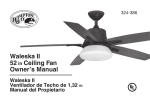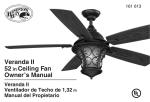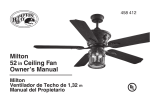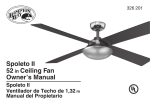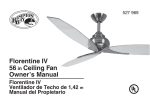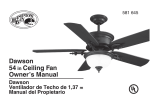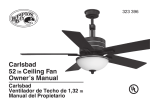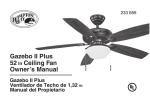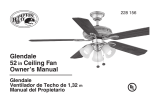Download Hampton Bay AG688-NI+WC Use and Care Manual
Transcript
248 291 Radcliffe 52 in Ceiling Fan Owner’s Manual Radcliffe Ventilador de Techo de 1,32 m Manual del Propietario Radcliffe by Hampton Bay ® 52” Radcliffe Ceiling Fan by Hampton Bay Thank you for purchasing our ceiling fan. This product has been manufactured with the highest standards of safety and quality. The finish of this fan is weather resistant, but over time will naturally weather and fade. Date Purchased Table of Contents Store Purchased Safety Rules . . . . . . . . . . . . . . . . . . . . 1 UL Model No. 248-291 Unpacking Your Fan . . . . . . . . . . . . . . 2 Installing Your Fan . . . . . . . . . . . . . . . 3 Serial No. Installing the Light Kit. . . . . . . . . . . . . 11 Operating Your Transmitter . . . . . . . . . . . 12 Vendor No. 219032 Care of Your Fan . . . . . . . . . . . . . . . . 13 Troubleshooting . . . . . . . . . . . . . . . . . 13 UPC 792145354253 Specifications . . . . . . . . . . . . . . . . . . 14 Warranty Information . . . . . . . . . . . . 15 Safety Rules - Read and Save These Instructions 1. To reduce the risk of electric shock, insure electricity has been turned off at the 10. After making electrical connections, spliced conductors should be turned circuit breaker or fuse box before beginning. upward and pushed carefully up into outlet box. The wires should be spread apart with the grounded conductor and the equipment-grounding conductor 2. All wiring must be in accordance with the National Electrical Code on one side of the outlet box and ungrounded conductor on the other side of “ANSI/NFPA 70-1999” and local electrical codes. Electrical installation the outlet box. should be performed by a qualified licensed electrician. 11. All set screws must be checked and retightened where necessary before 3. WARNING: To reduce the risk of electrical shock or fire, do not use this fan installation. with any solid-state fan speed control device. It will permanently damage the 12. WARNING: Use only with light kit marked "Suitable for Use in Wet electronic circuitry. Locations". 4. CAUTION: To reduce the risk of personal injury, use only the screws provided with the outlet box. WARNING 5. The outlet box and support structure must be securely mounted and capable of reliably supporting a minimum of 35 pounds, Use only UL Listed outlet boxes marked “FOR FAN SUPPORT”. TO REDUCE THE RISK OF PERSONALL INJURY, DO NOT BEND THE BLADE ARMS (ALSO REFERRED TO AS FLANGES), WHEN INSTALLING THE BRACKETS, BALANCING THE BLADES OR CLEANING THE FAN. DO NOT INSERT FOREIGN OBJECTS IN – BETWEEN ROTATING FAN BLADES. 6. The fan must be mounted with a minimum of 7 feet clearance from the trailing WARNING edge of the blades to the floor. 7. Avoid placing objects in the path of the blades. TO REDUCE THE RISK OF FIRE, ELECTRIC SHOCK OR PERSONAL INJURY, MOUNT FAN TO OUTLET BOX MARKED ACCEPTABLE FOR FAN SUPPORT WITH THE SCREWS PROVIDED WITH THE OUTLET BOX. 8. To avoid personal injury or damage to the fan and other items, be cautious when working around or cleaning the fan. 9. Do not use water or detergents when cleaning the fan or fan blades. A dry dust cloth or lightly dampened cloth will be suitable for most cleaning. 1 Unpacking Your Fan 2 5 Unpack your fan and check the contents. You should have the following items: 8 11 A B 12a 1 3 9 12b C 6 4 1. 2. 3. 4. 5. 6. Set of blades (5) Canopy assembly Ball/downrod assembly Coupling cover Fan motor assembly Blade arms (5) WARNING DO NOT INSTALL OR USE FAN IF ANY PART IS DAMAGED OR MISSING. CALL TOLL FREE 1-877-902-5588. 2 7 10 13 7. Switch housing 8. Light kit 9. Glass shade 10. Receiver with 6 wire nuts 11. 13 Watt compact fluorescent bulbs (2) 12a. Wall transmitter incl. 2 mounting screws and 3 wire nuts 12b. Wall plate w/2 mounting screws 13. Extra plastic plug A. Blade Attachment Hardware (16 Screws with Rubber Washers) B. Electrical Hardware (3 Plastic Wire Nuts) C. Balance Kit Installing Your Fan Tools Required Provide Strong Support Figures 1~3 are examples of different ways to mount the outlet box. Phillips screwdriver, straight slot screwdriver, step ladder and wire cutters. Recessed Outlet Box Ceiling Mounting Plate Figure 3 Mounting Options Outlet Box If there isn't an existing UL listed mounting box, then read the following instructions. Disconnect the power by removing fuses or turning off circuit breakers. Figure 1 Secure the outlet box directly to the building structure. Use appropriate fasteners and building materials. The outlet box and its support must be able to fully support the moving weight of the fan (at least 35 lbs). Do not use plastic outlet boxes. Note: You may need a longer downrod to maintain proper blade clearance when installing on a steep, sloped ceiling. The maximum angle allowable is 24°. If the canopy touches downrod, remove the decorative canopy bottom cover and turn the canopy 180° before attaching the canopy to the mounting plate. WARNING TO REDUCE THE RISK OF FIRE, ELECTRIC SHOCK OR PERSONAL INJURY, MOUNT FAN ONLY TO AN OULET BOX MARKED ACCEPTABLE FOR FAN SUPPORT AND USE THE MOUNTING SCREWS PROVIDED WITH THE OULET BOX. OUTLET BOX COMMONLY USED FOR THE SUPPORT OF LIGHTING FIXTURE MAY NOT BE ACCEPTABLE FOR FAN SUPPORT AND MAY NEED TO BE REPLACED. CONSULT A QUALIFIED ELECTRICIAN IF IN DOUBT. Outlet Box Figure 4 Outlet Box Figure 2 To hang your fan where there is an existing fixture but no ceiling joist, you may need an installation hanger bar as shown in Figure 4 (available at any Home Depot store). 3 Hanging the Fan REMEMBER to turn off the power. Follow the steps below to hang your fan properly. 1. Remove the decorative canopy bottom cover from the canopy by turning the cover counter clockwise. (Figure 5) 2. Remove the mounting bracket from the canopy by removing the 1 of 2 screws from the bottom of the mounting bracket and loosening the other one a half turn from the screw head. Next, turn the canopy counter clockwise to removing the mounting bracket from the canopy. (Figure 5) 5. Align the holes at the bottom of the downrod with the holes in the coupling on top of the motor housing. (Figure 6) Carefully insert the clevis pin through the holes in the collar and downrod. Be careful not to jam the clevis pin against the wiring inside the downrod. Insert the cotter pin through the hole near the end of the clevis pin until it snaps into its locked position, as noted in the circle inset of Fig. 6. WARNING Motor Wires Ball/Downrod Assembly Pin in Locked Positioon Ceiling Canopy Canopy Bottom Cover Coupling Cover Tighten Screw Firmly FAILURE TO PROPERLY INSTALL COTTER PIN AS NOTED IN STEP 5 COULD RESULT IN FAN LOOSENING AND POSSIBLY FALLING. 6. Tighten two set screws at top of the fan motor collar firmly and evenly. (Fig. 6) Clevis Pin Cotter Pin 3. Remove the clevis pin, cotter pin and set screws from the top of the motor assembly. (Figure 6) NOTE: If a longer downrod is needed, take out the screw located in the hanger ball, lower the hanger ball and remove the pin, remove all 3 pieces from the downrod and assemble them onto the new longer downrod before proceeding step 4. (The longer downrod is available at any Home Depot store) 4. Route wires exiting from the top of the fan motor through the coupling cover, canopy cover, canopy and then through the ball/ downrod. (Figure 6) 4 Ceiling Mounting Bracket Ceiling Canopy Canopy Bottom Cover Figure 5 Figure 6 Installing Fan to the Electrical Box UL Listed Outlet Box WARNING TO REDUCE THE RISK OF FIRE, ELECTRIC SHOCK OR OTHER PERSONAL INJURY. MOUNT FAN ONLY TO AN OUTLET BOX OR SUPPORTING SYSTEM MARKED ACCEPTABLE FOR FAN SUPPORT AND USE THE MOUNTING SCREWS PROVIDED WITH THE OUTLET BOX. 1. Pass the 120-volt supply wires through the center hole in the ceiling mounting bracket as shown in Figure 7. 120V Wires Ceiling Mounting Bracket Tab Figure 8 Mounting Screws (Supplied WARNING with Electrical Box) Figure 7 2. Install the ceiling mounting bracket on the outlet box with the screws and washers provided with your outlet box. (Figure 7) Tab Groove THE TAB IN THE RING MUST REST IN THE GROOVE OF THE HANGER BALL AS FIGURE 8. FAILURE TO PROPERLY SEAT THE TAB IN THE GROOVE COULD CAUSE DAMAGE TO WIRING. 3. Security tighten the two mounting screws. 4. Carefully lift the fan assembly up to the ceiling mounting bracket and seat the hanger ball in the mounting bracket socket. Make sure the tab on the mounting bracket socket is properly seated in the groove in the hanger ball. (Figure 8) This will help to balance the ceiling fan. 5 Making the Electrical Connections CAUTION WARNING 2. (Fig. 12) Motor to receiver electrical connections: Connect the black wire from the fan to black wire marked "TO MOTOR L". Connect the white wire from the fan to the white wire marked "TO MOTOR N" from the receiver. Connect the blue wire from the fan to the blue wire marked "For Light" from the receiver. Secure the wire connections with the plastic wire connecting nuts provided. TO AVOID POSSIBLE ELECTRICAL SHOCK, BE SURE ELECTRICITY IS TURNED OFF AT THE MAIN FUSE BOX BEFORE WIRING. If you feel you do not have enough electrical wiring knowledge or experience, have your fan installed by a licensed electrician. This remote control unit is equipped with 16 code combinations to prevent possible interference from or to other remote units. The frequency switches on your receiver and transmitter have been preset at the factory. Please recheck to make sure the switches on the transmitter and the receiver are set to the same position, any combination of settings will operate the fan as long as the transmitter and receiver are set to the same position. (Figure 9) CAUTION THE FREQUENCY SWITCHES ON THE RECEIVING UNIT ARE COVERED WITH A RUBBER COVER, REMOVE THE RUBBER COVER AND THEN HAVE IT REPLACED AFTER MAKING ANY CHANGES TO THE FREQUENCY SWITCHES. 1. Insert the receiver into the mounting bracket with the flat side of the receiver facing the ceiling. (Figure 10) 6 DO NOT USE WITH WALL LIGHT DIMMER SWITCH. (FIGURE 11) 3. (Figure 12) Receiver to house supply wires electrical connections: Connect the black (hot) wire from the ceiling to the black wire marked "AC in L" from the receiver. Connect the white(neutral) wire from the ceiling to the white wire marked "AC in N" from the receiver. Secure the wire connections with the plastic wire connecting nuts provided. 4. (Figure 12) If your outlet box has a ground wire (green or bare copper) connect it to the fan ground wires; otherwise connect the hanging bracket ground wire to the mounting bracket. Secure the wire connection with a plastic wire connecting nut provided. After connecting the wires spread them apart so that the green and white wires are on one side of the outlet box and black and blue wires are on the other side. Carefully tuck the wire connections up into the outlet box. Frequency Switch Figure 9 Receiver Ceiling Mounting Bracket Figure 10 Figure 11 AC120V Ground Conductor WHITE BLUE BLACK BLACK BLUE WHITE Ground to Downrod AC SUPPLY BLUE BLACK WHITE Green Black Black Green Ground Lead Wall Control GREEN Outlet Box WHITE INPUT BLACK WHITE BLACK BLACK WHITE SUPPLY CIRCUIT Ground Black Black BLUE BLACK WHITE GROUND GREEN Figure 13 Figure 12 7 WARNING Installing the Wall Transmtter MAKE SURE THE TAB ON THE MOUNTING BRACKET PROPERLY SITS IN THE GROOVE IN THE HANGER BALL BEFORE ATTACHING THE CANOPY TO THE BRACKET BY TURNING THE HOUSING UNTIL IT DROPS INTO PLACE. Remember to shut the power off at the circuit breaker or fuse box. WARNING HOOK UP IN "SERIES ONLY" DO NOT CONNECT THE HOT AND NEUTRAL WIRES OF ELECTRIC CIRCUIT TO THE TRANSMITTER WALL SWITCH - DAMAGE TO THE SWITCH AND POSSIBLE FIRE COULD OCCUR. Outlet Box Figure 14 1. Remove the existing wall plate and switch from the wall junction box. Ceiling Mounting Bracket Screw Finishing the Fan Installation 2. Make the electrical connections as shown in Figure 13. If your outlet box has a ground wire (green or bare copper) connect the wall transmitter's ground wire to it; otherwise 1. Tuck connections neatly into ceiling outlet box. connect the wall transmitter's ground wire directly to one of the screws from the outlet box. 2. Slide the canopy up to mounting bracket and place the key hole on the canopy over the 3. (Fig. 14) Carefully tuck the wire connections screw on the mounting bracket, turn canopy inside the junction box. Secure the wall until it locks in place at the narrow section of transmitter with the two screws provided. the key holes. (Fig. 15) Attach the wall plate over the wall transmitter and secure with the two screws provided. 3. Align the circular hole on canopy with the remaining hole on the mounting bracket, secure by tightening the two set screws. Note: Adjust the canopy screws as necessary until the canopy and canopy cover are snug. 8 Canopy Screw Canopy Bottom Cover Figure 15 Attaching the Fan Blades CAUTION REMOVE THE 3 SCREWS FROM THE MOTOR SUPPORT PLATE, DISCARD THE 3 SCREWS AND MOTOR SUPPORT PLATE. Blade Screws with Rubber Washers Blade Arm Motor Tab 1. Attach blades to blade arm using the screws and rubber washers provided. (Fig. 16) Start a screw into the blade arm, do not tighten. Repeat for the 3 remaining screws and washers. 2. Tighten each screw securely starting with the center screw. Make sure the blade is straight. Repeat steps for the remaining blades. Slot Figure 16 Screws 3. Fasten the blade assemblies to the motor housing by lining up the slots of the blade arms with the tabs on the motor housing, then tighten the two screws and washers already installed in the blade arms. (Figure 17) Blade Arm Figure 17 WARNING TO REDUCE THE RISK OF PERSONAL INJURY, DO NOT BEND THE BLADE ARMS WHILE INSTALLING, BALANCING THE BLADES, OR CLEANING THE FAN. DO NO INSERT FOREIGN OBJECTS BETWEEN ROTATING FAN BLADES. 9 Blade Balancing The following procedure should correct most fan wobble. Check after each step. 1. Check that all blade and blade bracket screws are secure. 2. Most fan wobble problems are caused when blade levels are unequal. Check this level by selecting a point on the ceiling above the tip of one of the blades. Measure from a point on the center of each blade to the point on the ceiling. Measure this distance as shown in Figure 18. Rotate the fan until the next blade is positioned for measurement. Repeat for each blade. Measurements deviation should be within 1/8˝. Run the fan for 10 Minutes. 3. Use the enclosed Blade Balancing Kit if the blade wobble is still noticeable. Touching Ceiling Figure 18 10 Installing the Switch Housing 1. Remove 1 of the 3 screws from the mounting ring and loosen the other 2 screws. (Do not remove) 2. While holding the switch housing under your fan, snap together the wire connection plugs . 3. Place the key holes on the switch housing over the 2 screws previously loosened from the mounting ring, turn switch housing until it locks in place at the narrow section of the key holes. Secure by tightening the 2 screws previously loosened and the one previously removed. (Fig. 19) Wire Connection Plugs Mounting Ring Switch Housing Screws Figure 19 Installing the Light Kit Fan without Light Kit CAUTION 1. Disassembling the switch housing cover from light kit originally pre-installed on the ceiling fan. (Optional) BEFORE STARTING INSTALLATION, DISCONNECT THE POWER BY TURNING OFF THE CIRCUIT BREAKER OR REMOVING THE FUSE AT FUSE BOX. TURNING POWER OFF USING THE FAN SWITCH IS NOT SUFFICIENT TO PREVENT ELECTRIC SHOCK. 1. While holding the light kit assembly under your fan, Make the polarized plug connections: (Fig. 20) - White to white - Blue to black 2. Attach the extra plastic plug to the switch housing cover. (Fig. 21) 3. Install the switch housing cover to the switch housing with screws provided. (Fig. 21) Wire Connection Plugs Bulbs 2. Carefully push all wires back into the switch housing, then install the light kit assembly onto the mounting plate with 3 screws provided. Be sure to tighten all screws. (Fig. 20) 3. Install 2 x 13 watt (Max.) compact fluorescent bulbs (included). (Fig. 20) NOTE: CFL bulbs are NOT dimmable. Light Kit Assembly Switch Housing Glass Shade 4. Place glass shade over the light kit and secure it with the finial provided. DO NOT OVER TIGHTEN. (Fig. 20) 5. Restore power and your light kit is ready for operation. Screws Finial Figure 20 NOTE LIGHT BULBS HAVE NO WARRANTY; CAN BE PURCHASED AT ANY HOME DEPOT STORE. Switch Housing Cover Screws Plastic Plug Figure 21 11 Cool weather - (Clockwise direction) An upward airflow moves warm air off the ceiling area. (Fig. 24) This allows you to set your heating unit on a lower setting without affecting your comfort. Operating Your Transmitter Restore power to the ceiling fan and test for proper operation. 1. "HI, MED, LOW" buttons: These three buttons are used to set the fan speed as follows: LOW=Low speed MED=Medium speed HI=High speed 2. "FAN OFF" button: This button turns the fan off. 3. The "LIGHT" button turns the light ON or OFF. (NOTE: The light is NOT dimmable.) 4. "OFF-ON " Slide Button: This button turns the power Off and On to the Fan and Light(s). Figure 22 Speed settings for warm or cool weather depend on factors such as the room size, ceiling height, number of fans, etc. Figure 23 The Reverse switch is located on the top of switch housing. Slide the switch to the Left for warm weather operation. Slide the switch to the Right for cool weather operation. NOTE WAIT FOR FAN TO STOP BEFORE CHANGING THE SETTING OF THE SLIDE SWITCH. Warm weather - (Counter-Clockwise direction) A downward air flow creates a cooling effect.(Fig. 23) This allows you to set your air conditioner on a higher setting without affecting your comfort. 12 Figure 24 Care of Your Fan Troubleshooting Here are some suggestions to help you maintain your fan. 1. Because of the fan's natural movement, some connections may become loose. Check the support connections, brackets, and blade attachments twice a year. Make sure they are secure. (It is not necessary to remove fan from ceiling.) PROBLEM SOLUTION Fan will not start 1. Check main and branch circuit fuses or breakers. 2. Check line wire connections to the fan and switch wire connections in the switch housing. 3. Check to make sure the dip switches from the transmitter and receiver are set to the same frequency. Fan sounds noisy 1. Make sure all motor housing screws are snug. 2. Make sure the screws that attach the fan blade bracket to the motor hub is tight. 3. Make sure wire nut connections are not rattling against each other or the interior wall of the switch housing. 4. Allow a 24-hour "breaking-in" period. Most noises associated with a new fan disappear during this time. 5. If using ceiling fan light kit, make sure the screws securing the glassware are tight. Check that the light bulb is also secure. 6. Make sure there is a short distance from the ceiling to the canopy. It should not touch the ceiling. 7. Make sure your ceiling box is secure and rubber isolator pads are used between mounting bracket and outlet box. Remote control 1. Do not connect the fan with a wall mounted variable speed control(s). 2. Make sure the dip switches are set correctly. 2. Clean your fan periodically to help maintain its new appearance over the years. Do not use water when cleaning. Use only a soft brush or lint-free cloth to avoid scratching the finish. The plating is sealed with a lacquer to minimize discoloration or tarnishing. Do not use water when cleaning. This could damage the motor, or the wood, or possibly cause an electrical shock. 3. You can apply a light coat of furniture polish to the wood blades for additional protection and enhanced beauty. Cover small scratches with a light application of shoe polish. 4. There is no need to oil your fan. The motor has permanently lubricated sealed ball bearings. WARNING MAKE SURE THE POWER IS OFF AT THE ELECTRICAL PANEL BOX BEFORE YOU ATTEMPY ANY REPAIRS. REFER TO THE SECTION, “MAKING ELECTRICAL CONNECTIONS”. 13 Specifications FAN SIZE SPEED VOLTS AMPS LOW 52” MED. HIGH 120 WATTS RPM CFM xxx xxx xxx xxx xxx xxx xxx xxx xxx xxx xxx xxx These are approximate measures. They do not include Amps and Wattage used by the light kit. 14 N.W. G.W. C.F. xxx kgs (xxx lbs) xxx kgs (xxx lbs) xxx’ Hampton Bay Lifetime Limited Warranty (lifetime warranty on motor) The Hampton Bay warrants the fan motor to be free from defects in workmanship and material present at time of shipment from the factory for a period of lifetime after the date of purchase by the original purchaser. Hampton Bay also warrants that all other fan parts, excluding any glass or acrylic blades, to be free from defects in workmanship and material at the time of shipment from the factory for a period of one year after the date of purchase by the original purchaser. We agree to correct such defects without charge or at our option replace with a comparable or superior model if the product is returned to Hampton Bay. To obtain warranty service, you must present a copy of the receipt as proof of purchase. All costs of removing and reinstalling the product are your responsibility. Damage to any part such as by accident or misuse or improper installation or by affixing any accessories, is not covered by this warranty. Because of varying climatic conditions this warranty does not cover any changes in brass finish, including rusting, pitting, corroding, tarnishing or peeling. Brass finishes of this type give their longest useful life when protected from varying weather conditions. A certain amount of “wobble” is normal and should not be considered a defect. Servicing performed by unauthorized persons shall render the warranty invalid. There is no other express warranty. Hampton Bay hereby disclaims any and all warranties, including but not limited to. Those of merchantability and fitness for a particular purpose to the extent permitted by law. The duration of any implied warranty which cannot be disclaimed is limited to the time period as specified in the express warranty. Some states do not allow limitation on how long an implied warranty lasts, so the above limitation may not apply to you. The retailer shall not be liable for incidental, consequential, or special damages arising out of or in connection with product use or performance except as may otherwise be accorded by law. Some states do not allow the exclusion of incidental or consequential damages, so the above exclusion or limitation may not apply to you. This warranty gives specific legal rights, and you may also have other rights which vary from state to state. This warranty supersedes all prior warranties. Shipping costs for any return of product as part of a claim on the warranty must be paid by the customer. You must present a copy of the original purchase receipt to obtain warranty service. Ceiling Fan Parts & Service Department 2919 E. Philadelphia Street Ontario, Ca 91761 Attach receipt here for easy location 15



















